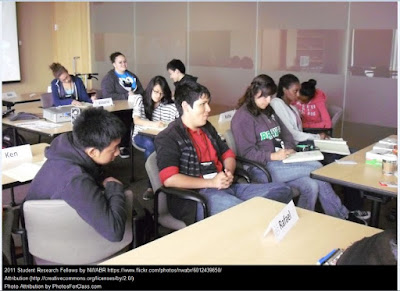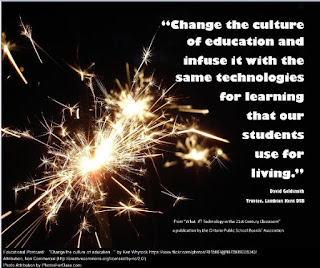As educators, we have primary and secondary purposes with
our students. The primary, and most obvious purpose, is to teach our students
content: reading, writing, math, science, social sciences, music and other core
and extra curriculum. The secondary, and I would argue equally if not more
important purpose, is to grow students into responsible members of society. At
the top of this curriculum would be to help students grow and develop their
respectful and ethical minds. These are two critical skills that students must
have in order to find success at almost any career they might pursue, and to
interact well in the world in general.
In identifying the five minds for the future, Howard
Gardner defines the respectful mind as, “Responding sympathetically and
constructively to differences among individuals and among groups; seeking to
understand and work with those who are different, extending beyond mere
tolerance and political correctness” (Gardner, 2008). Additionally, he “call(s) on human beings to
accept the differences, learn to live with them, and value those who belong to
other cohorts (groups)” (Gardner, 2008). Gardner is describing how humans
should act with and about each other, regardless of background, values, culture
or ethnicity. The training for respect begins at a very young age as children
watch the interactions of adults around them and take their cues for expected
behavior from them. Also, children are directly taught about respect in school,
by learning and practicing expected respectful behavior with teachers and other
adults in school, peers, and other adults involved in school activities. Many
schools have prepared lessons solely on what respect looks like, how to be
respectful, and how to handle disrespectful interactions. Still, educators also
use less direct methods to teach respect as well. These may be even more
important than direct instruction because it infuses respect into the “work”
environment of school so that it flows more naturally, as it would in a work
setting.
Two tools that can be used to help students develop their
respectful minds in the classroom are Board Builder on
Discovery Education and Glogster. Both
of these web tools allow teachers and students to create interactive digital
boards that can be used to either support instruction, or to create content.
Teachers can use these tools to create boards that students then use as
resources or to complete independently (as in a center or for a flipped
classroom). One way this tool could be used by teachers to teach respect is to
create a board that directly instructs on another culture, a social issue, an
environmental issue, or another part of society that the students may not be
familiar with. These lessons can foster understanding and students can begin to
learn about and respect the differences between themselves and a unique group
of people. Activities that develop respect and understanding can be included.
Students could also use these tools to create projects that evidence their learning
about groups that are different from themselves, problems that society must
find solutions for, respect for other organisms on Earth, or unique solutions
to social issues of the day. Students can create these independently, or in a
group, which requires collaborative work, another situation in which students
must practice respect to successfully complete the work.
Gardner’s final of the fifth minds is the ethical mind.
Gardner defines the ethical mind as “abstracting crucial features of one’s role
at work and one’s role as a citizen and acting consistently with those
conceptualizations; striving toward good work and good citizenship” (Gardner,
2008). He goes on to describe the three ways in which work can be good; “work
can be good in the sense of being excellent
in quality”, “work may be good in the sense of being responsible – taking into account implications for the wider
community”, “work may be good in the sense of feeling good – it is engaging and meaningful” (Gardner, 2008). As
educators, the ethical mind can seem more difficult to address as getting
students to see the value of work can
sometimes be difficult. Gardner offers a prescription for this in saying, “Educators
can smooth the road to the ethical mind by drawing attention to the other
connotations of goodness. Students need to understand why they are learning what they are learning and how this knowledge can be put to
constructive uses” (Gardner, 2008). It would seem to be imperative to help
students understand how what they are learning in school will not only prepare
them for their life after school, but also how it will benefit them in
attaining a career that they can consider “good work”. The age old question “Why
do I need to know this?” would seem to have more value than educators
traditionally consider!
We can again look to the tools of Board Builder and
Glogster to not only support instruction that helps develop the ethical mind,
but also supports student “work” to practice using the ethical mind. Teachers
again can use these tools to provide content and practice for students in the
content. These tools provide new and innovative strategies for instruction,
which can lead to increased student engagement and participation, demonstrating
the need to actively participate in their own education. If they are truly
engaged, not passive observers, they can practice the skill of being responsible.
Being responsible for your own requirements is a part of ethical behavior,
rather than passively letting someone else do what is rightly your job.
Students can also create content to demonstrate their learning or report on
research or understanding of issues as they relate to ethical or “good” work.
Students can see the importance of being active participants in a society and
contributing to the overall good. These are lessons that will help them see the
part they play in a healthy society and the harm that can be caused when
members of a society do not contribute, but only draw on the work of others.
Developing the respectful and ethical mind in students is
as important of a job as teaching them traditional curriculum. Whether this
instruction is directly through lessons and activities, or indirectly through modeling
and experiences, they are critical skills that must be addressed in education.
Using web tools such as Board Builder or Glogster can reach our students as the
digital natives they are, supporting the development of these minds to help
them achieve success in the world beyond school.
Sources:
Discovery Education. 50 Ways to use board builder. Retrieved on August 8, 2015 from https://mediashare.discoveryeducation.com/mediashare/index.cfm?event=pushFile&guidAssetMediaFileId=59A97796-A2E1-276A-EF9C-B5C11E7CBC8D.
Gardner, Howard. (2008). Five minds for the future. Boston, MA. Harvard Buisiness School Publishing.
Newlearninguk's channel. (2009). Glogster in 90 seconds. Retrieved on August 8, 2015 from https://www.youtube.com/watch?v=MvC47fUANLk.
Moore, Sam. (2014). Discovery Education board builder. Retrieved on August 8, 2015 from https://www.youtube.com/watch?v=c4jtRl7XKZ4 .

























